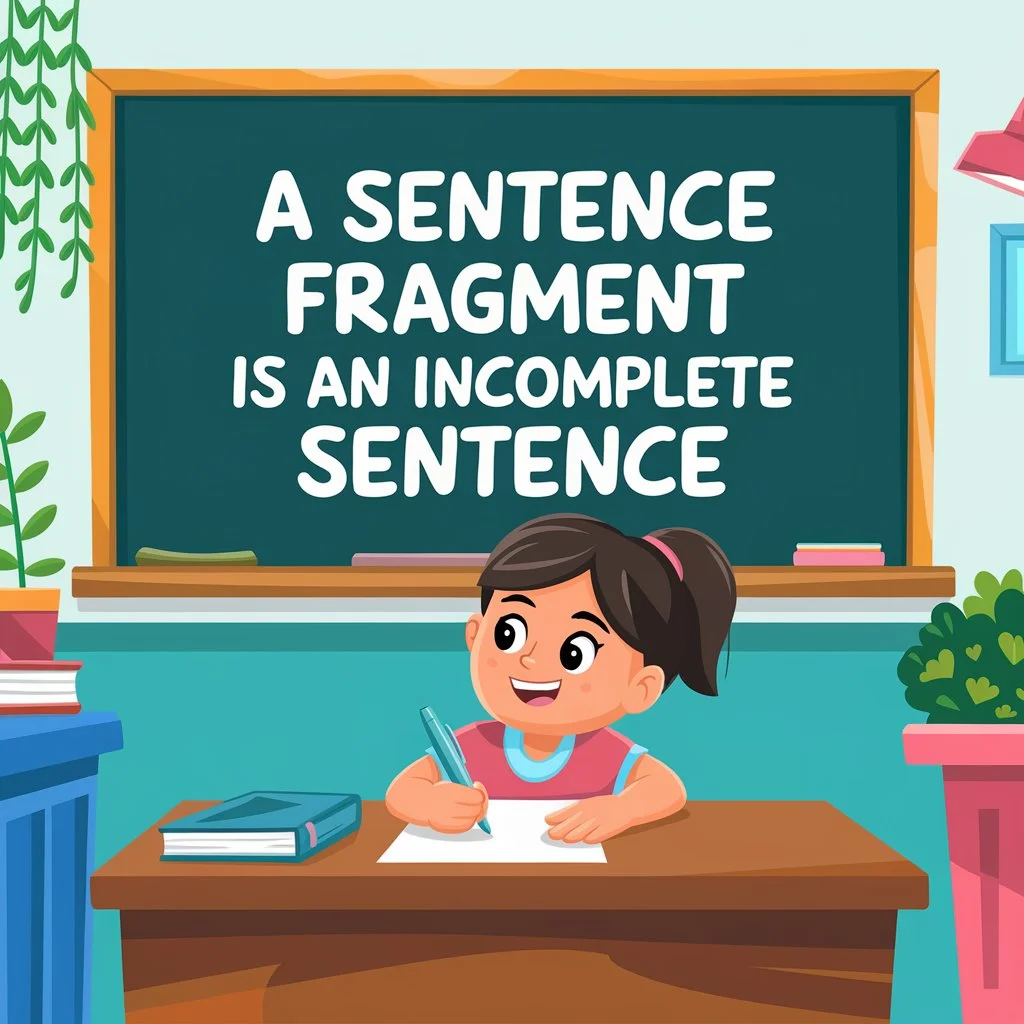A sentence fragment is a part of a sentence that doesn’t have a subject, verb, or a complete thought. These fragments can confuse your reader and make your writing unclear. By learning how to spot and fix them, you can make your writing stronger and easier to understand. In this guide, we’ll explore what sentence fragments are, how to avoid them, and how to write clear, complete sentences.
A sentence fragment is an incomplete sentence. It lacks the essential parts that make it a full thought. Typically, a complete sentence contains a subject and a verb, and it expresses a complete idea. However, sentence fragments miss one or more of these components, leading to confusion in writing. Have you ever read a sentence that felt incomplete? That’s likely because it was a sentence fragment, a common writing mistake.
Why Sentence Fragment Occur
Sentence fragments often occur when we write in a rush or don’t proofread our work. Sometimes, we may think we’ve written a full sentence, but it’s only a part of a thought. Here’s why fragments happen:
- Missing Subject or Verb: Often, one of these elements is absent, making the sentence feel incomplete.
- Dependent Clauses: These clauses rely on the rest of the sentence to complete their meaning. On their own, they feel unfinished.
- Phrases as Sentences: Sometimes, writers mistake phrases for sentences. A phrase, while useful, cannot stand alone.
Let’s explore a few examples to better understand this.
Examples of Sentence Fragment
- Fragment: “After the movie.” Complete Sentence: “After the movie, we went out for ice cream.”
- Fragment: “Waiting for the bus.” Complete Sentence: “She was waiting for the bus when it started to snow.”
- Fragment: “Because it was raining.” Complete Sentence: “Because it was raining, we decided to stay indoors.”
- Fragment: “While cooking dinner.” Complete Sentence: “While cooking dinner, she listened to her favorite podcast.”
- Fragment: “Before the sun set.” Complete Sentence: “Before the sun set, we finished our hike.”
- Fragment: “During the game.” Complete Sentence: “During the game, the crowd cheered loudly.”
- Fragment: “Without a plan.” Complete Sentence: “Without a plan, they ventured into the city.”
- Fragment: “After school.” Complete Sentence: “After school, he went straight to the library.”
- Fragment: “Until I heard the news.” Complete Sentence: “Until I heard the news, I didn’t realize how serious it was.”
- Fragment: “Even though it was cold.” Complete Sentence: “Even though it was cold, they still went for a walk.”
- Fragment: “While reading the book.” Complete Sentence: “While reading the book, she fell asleep.”
- Fragment: “Before the party started.” Complete Sentence: “Before the party started, we decorated the house.”
- Fragment: “After the storm.” Complete Sentence: “After the storm, the sky cleared and the sun came out.”
- Fragment: “As soon as I arrived.” Complete Sentence: “As soon as I arrived, the meeting began.”
- Fragment: “During the test.” Complete Sentence: “During the test, the teacher walked around the room.”
- Fragment: “Although I tried hard.” Complete Sentence: “Although I tried hard, I couldn’t solve the problem.”
- Fragment: “In the middle of the night.” Complete Sentence: “In the middle of the night, the baby woke up crying.”
- Fragment: “While watching TV.” Complete Sentence: “While watching TV, she snacked on popcorn.”
- Fragment: “After we finished dinner.” Complete Sentence: “After we finished dinner, we watched a movie together.”
- Fragment: “Despite the challenges.” Complete Sentence: “Despite the challenges, he completed the project on time.”
In both examples, the fragments lack a complete thought. The first one needs more information after “Because,” and the second one lacks a subject (who was running?).
Types of Sentence Fragment
Not all sentence fragments are the same. There are different types of fragments based on what’s missing or incomplete in the sentence.
Dependent Clause Fragments
A dependent clause is a group of words that has a subject and a verb, but it doesn’t express a complete thought. When a dependent clause is written on its own, it becomes a fragment. Dependent clauses usually start with words like because, although, or since.
- Fragment: “Although I studied hard.”
- Complete Sentence: “Although I studied hard, I didn’t pass the test.”
Dependent clauses need an independent clause to complete their meaning.
Missing Subject or Verb Fragments
A missing subject or verb fragment is when either the subject or the verb is left out, making the sentence feel incomplete. Without both parts, there’s no way to understand who or what is acting and what action is happening.
- Fragment: “Walking to the store.”
- Complete Sentence: “She was walking to the store.”
In this case, the subject “she” was missing.
Phrase Fragments
A phrase fragment occurs when a group of words looks like a sentence but doesn’t have both a subject and a verb. Prepositional phrases or participle phrases are common causes of phrase fragments.
- Fragment: “After the rain.”
- Complete Sentence: “After the rain, the sun came out.”
Prepositional phrases like “after the rain” need the rest of the sentence to give context and meaning.
Appositive Fragments
An appositive fragment is when an appositive (a noun or noun phrase that renames another noun) is written as a sentence on its own. However, appositives cannot stand alone and should be part of a larger sentence.
- Fragment: “A brilliant scientist.”
- Complete Sentence: “Marie Curie, a brilliant scientist, made groundbreaking discoveries in radiation.”
Here, “a brilliant scientist” is just an extra piece of information about Marie Curie, and it doesn’t form a complete thought on its own.
How to Fix Sentence Fragment
Now that we understand what sentence fragments are, how can we fix them? There are simple strategies that can turn fragments into complete, clear sentences.
Step-by-Step Guide
- Identify the Missing Element: Is it a subject, verb, or a complete thought?
- Add the Missing Part: Add the subject or verb to make the sentence complete.
- Combine with a Complete Sentence: If it’s a dependent clause or a phrase, combine it with a full sentence.
Common Fixes for Sentence Fragments
Let’s look at common fragment issues and how to correct them:
- Missing Subject:
- Fragment: “Running fast through the woods.”
- Complete: “He was running fast through the woods.”
- Missing Verb:
- Fragment: “The man with the blue hat.”
- Complete: “The man with the blue hat walked into the room.”
- Dependent Clause:
- Fragment: “Although I wanted to go to the party.”
- Complete: “Although I wanted to go to the party, I had to stay home and study.”
Using Conjunctions to Avoid Fragment In A Sentence
Conjunctions like and, but, or because can help connect sentence fragments to form a complete sentence. They link phrases or clauses together to provide full meaning.
- Fragment: “The dog barked loudly. Because it saw a stranger.”
- Complete Sentence: “The dog barked loudly because it saw a stranger.”
Here, using “because” correctly ties the two parts together into a full sentence.
Avoiding Sentence Fragment in Writing
Preventing sentence fragments is easier when you understand the rules of sentence structure. Let’s go over some tips that can help you avoid these common mistakes.
Grammar Tips to Eliminate Fragments
- Always check for subject and verb: Every sentence needs both a subject and a verb.
- Watch out for dependent clauses: Make sure they are connected to an independent clause.
- Complete the thought: Don’t leave readers guessing; finish your sentence with a full idea.
By following these tips, your writing will become clearer and more professional.
Proofreading for Fragments
Proofreading is essential for catching sentence fragments. When reviewing your writing, ask yourself:
- Does every sentence have a subject and a verb?
- Is the sentence expressing a complete thought?
- Can the sentence stand on its own?
You can also use grammar tools like Grammarly or Hemingway to spot and correct sentence fragments automatically. These tools highlight incomplete sentences and suggest ways to fix them.
Exercises and Practice
Practicing with sentence fragment worksheets can help you improve your understanding of how to fix fragments. Below is an example to practice:
- Fragment: “While waiting for the bus.”
- Complete Sentence: “While waiting for the bus, she read a book.”
Work through exercises like these to build your sentence structure skills.
The Importance of Complete Sentences in Writing
Understanding sentence fragments is key to improving your writing, but why are complete sentences so important?
Impact on Readability
Complete sentences make your writing clearer and easier to follow. When sentences are complete, the reader doesn’t have to guess what you mean. In contrast, fragmented sentences disrupt the flow of your writing, making it confusing.
Common Sentence Structure Mistakes
Beyond fragments, other sentence structure mistakes include run-on sentences and comma splices. These issues can also make writing hard to read. To write clearly:
- Use proper punctuation: A comma or period can make a big difference.
- Avoid overly long sentences: Keep sentences concise and clear.
Following these guidelines ensures that your readers can follow your complete thoughts.
FAQs
What is a sentence fragment?
A sentence fragment is a part of a sentence that is incomplete. It might be missing a subject, verb, or doesn’t express a complete thought. To fix it, you need to add the missing part or connect it to another sentence.
How do I know if a sentence is a fragment?
Check if the sentence has a subject (who or what the sentence is about) and a verb (the action). If it doesn’t, or if the sentence doesn’t express a full idea, it’s probably a fragment. Fragments feel unfinished when you read them.
Can a phrase be a sentence?
No, a phrase cannot be a complete sentence on its own. It may give part of the idea but lacks either a subject, verb, or complete thought. You need to add more information to turn it into a full sentence.
What’s the difference between a dependent clause and a fragment?
A dependent clause has a subject and a verb but doesn’t express a complete thought. When written alone, it becomes a fragment. To fix it, combine it with an independent clause that completes the idea.
Why are sentence fragments bad in writing?
Sentence fragments can confuse readers because they don’t deliver a complete idea. They interrupt the flow of writing and make it harder to understand. Full sentences help your message come across clearly.
How can I fix sentence fragments in my writing?
To fix sentence fragments, add the missing subject or verb, or combine the fragment with a complete sentence. Proofread your work to spot any incomplete thoughts before finalizing your writing.
What’s the difference between a fragment and a run-on sentence?
A fragment is an incomplete sentence, while a run-on sentence is when two complete sentences are joined without proper punctuation. To fix a run-on, use a period, semicolon, or conjunction to separate the sentences.
Are sentence fragments ever okay to use?
Yes, sentence fragments can be used in creative writing or casual conversation to add emphasis or style. However, in formal writing, it’s best to avoid them to ensure clarity and completeness.
Conclusion
Sentence fragments are a common issue in writing, but they are easy to fix once you know how. Remember:
- Identify the missing parts: Check for subjects, verbs, and complete thoughts.
- Fix or combine fragments: Use conjunctions or add missing elements to complete the sentence.
- Practice regularly: Use worksheets and proofreading tools to improve your writing.
By applying these tips, you’ll soon be writing with clear, complete sentences that enhance your message and help you communicate more effectively!

I’m Mira Sinclair, the expert helping you navigate grammar sections at “Grammer Grove.” Playing with words and expressions is my thing. At Grammer Grove, we’re here to make yourwriting stand out and shine. Let’s make your appreciation heartfelt and memorable—come and join the fun at Grammer Grove!












